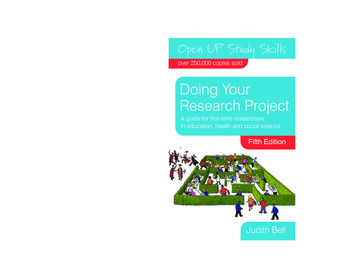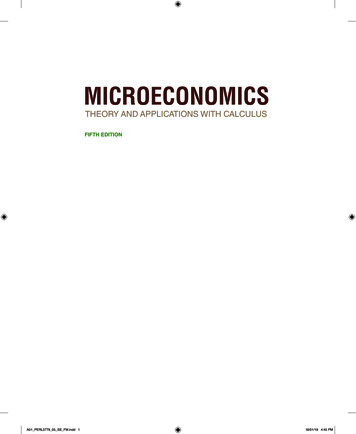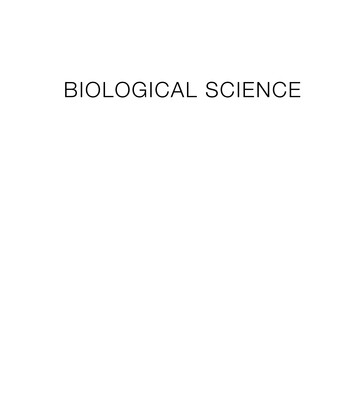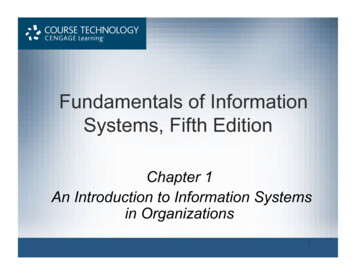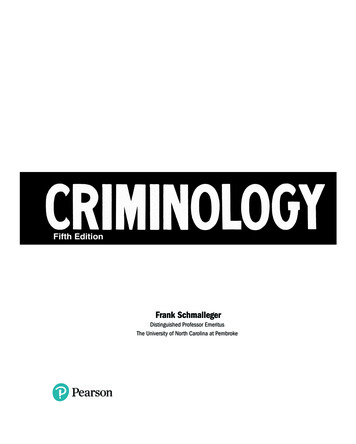
Transcription
Fifth EditionFrank SchmallegerDistinguished Professor EmeritusThe University of North Carolina at PembrokeA01 SCHM6251 05 SE FM.indd 111/2/18 9:49 PM
Vice President, Portfolio Management: Andrew GilfillanPortfolio Manager: Gary BauerPortfolio Management Assistant: Lynda CramerVice President, Product Marketing: Brad ParkinsProduct Marketing Manager: Heather TaylorProduct Marketing Assistant: Liz BennettDirector, Digital Studio and Content Production: Brian HylandManaging Producer: Cynthia ZonneveldContent Producer: Holly ShufeldtContent Producer: Neha SharmaManager, Rights Management: Johanna BurkeOperations Specialist: Deidra HeadleeCreative Digital Lead: Mary SienerManaging Producer, Digital Studio: Autumn BensonContent Producer, Digital Studio: Maura SnowFull-Service Management and Composition: Integra SoftwareServices Pvt. Ltd.Full-Service Project Manager: Philip AlexanderCover Design: Studio MontageCover Photo: Christian Mueller/ShutterstockPrinter/Bindery: To comeCover Printer: To comeText Font: Times LT Pro 10/12Copyright 2020, 2018, 2016 by Pearson Education, Inc. 221 River Street, Hoboken, NJ 07030. All rights reserved.Manufactured in the United States of America. This publication is protected by Copyright, and permission should be obtained from thepublisher prior to any prohibited reproduction, storage in a retrieval system, or transmission in any form or by any means, electronic,mechanical, photocopying, recording, or likewise. For information regarding permissions, request forms, and the appropriate contactswithin the Pearson Education Global Rights and Permissions department, please visit www.pearsoned.com/permissions/.Acknowledgments of third-party content appear on the appropriate page within the text.Unless otherwise indicated herein, any third-party trademarks, logos, or icons that may appear in this work are the property of theirrespective owners, and any references to third-party trademarks, logos, icons, or other trade dress are for demonstrative or descriptivepurposes only. Such references are not intended to imply any sponsorship, endorsement, authorization, or promotion of Pearson’sproducts by the owners of such marks, or any relationship between the owner and Pearson Education, Inc., or its affiliates, authors,licensees, or distributors.Library of Congress Cataloging-in-Publication DataNames: Schmalleger, Frank, author.Title: Criminology / Frank Schmalleger.Description: Fifth edition. Hoboken, NJ : Pearson Education, [2020] Series: Justice seriesIdentifiers: LCCN 2018025962 ISBN 9780135186251 ISBN 0135186250Subjects: LCSH: Criminology. LCGFT: Textbooks.Classification: LCC HV6025 .S344 2020 DDC 364–dc23 LC record available at https://lccn.loc.gov/2018025962118ISBN 10:0-13-518625-0ISBN 13: 978-0-13-518625-1A01 SCHM6251 05 SE FM.indd 211/2/18 9:49 PM
DedicationFor Avaand MaliaA01 SCHM6251 05 SE FM.indd 311/2/18 9:49 PM
Major Theoretical DevelopmentsClassical SchoolBiological andBiosocial TheoriesPsychological/Psychiatric TheoriesSocial StructureApproachesClassical CriminologyEarly PositivismModeling TheorySocial Disorganization1764 Cesare Beccaria Deterrencethrough punishment, free will,social contract1789Jeremy Bentham Hedonisticcalculus, utilitarianism1810189019731920Neoclassical Criminology19741975198619881992Robert Martinson Nothingworks doctrineJames Q. Wilson Thinkingabout crimeClarke & Cornish RationalchoiceJack Katz Seductions ofcrime, emotions and crimeClarke & Cornish Situationalchoice, situational crimeprevention1830sFranz JosephGall Phrenology, scientificunderstanding of crimeJohann GasparSpurzheim Broughtphrenology to AmericaCriminal Anthropology186319131939Cesare Lombroso Atavism,born criminals, criminaloids,Italian SchoolCharles BuckmanGoring Challenged Lombroso’stheoryEarnest Hooton Environment low-grade human crimeCriminal Families187719121915Richard Dugdale The JukefamilyHenry Goddard The KallikakfamilyArthur EstabrookConstitutional Theories19251949ErnstKretschmer SomatotypingWilliam Sheldon Body types,behavioral genetics/twins,heritability, human genomePsychoanalytic Criminology1920s– SigmundFreud Psychoanalysis,1930s Id, ego, superego, sublimation1930s August Aichorn Damagedegos194119641968HerveyCleckley Psychopathology,psychopath, sociopathHans Eysenck Traits,supertraitsDSM-II Antisocial personalitydisorderB. F. Skinner OperantConditioning, operant tration–Aggression Theory1939J. Dollard Displacement,catharsisCognitive Theory1955Jean Piaget Stages of humanintellectual developmentLawrence Kohlberg Stagesof moral developmentStanton Samenow andSamuel Yochelson Thecriminal mindsetRoger Shank and RobertAbelson Script theoryBiosocial Criminology197919801997Crime as Adaptation20102010198219871950s197119951998John Bowlby Secureattachment, anxious resistantattachment, anxious avoidanceattachmentS. M. Halleck Alloplasticadaptation, autoplasticadaptationLinksy, Bachman, StrausSocietal stress, aggressionDonald Andrews and JamesBonta Criminogenic needs,criminogenic domainsThomas & ZnanieckiDisplaced immigrantsPark & Burgess SocialecologySocial pathology, concentriczones (Chicago School)Shaw & McKayCultural transmission (ChicagoSchool)Oscar NewmanDefensible spaceJames Q. Wilson & GeorgeL. KellingBroken windows,criminology of placeRodney Stark Theory of deviantneighborhoodsCulture Conflict192719431970200319731950s1970s1975Darrell J. SteffensmeierAnthony WalshEnvironmental mediation ofgenetic influencesAdrian Raine BraindysfunctionKevin M. Beaver andAnthony Walsh BiosocialcriminologyThomas Bernard Genderratio problemKevin M. Beaver, JohnP. Wright, and AnthonyWalsh Evolutionary theory192919381969Edward O. Wilson Altruism,territoriality, tribalism, survivalof gene pool1930sBehavior TheorySociobiology1990sA01 SCHM6251 05 SE FM.indd 4Karl Christiansen andSarnoff Mednick Geneticdeterminism1920sPersonality TheoryTwin studies1968Gabriel Tarde ImitationAlbert Bandura Aggression islearned, aggression is rewarded,disengagement, social cognitiontheory, modeling1955195719581960s1967Frederic ThrasherGangs and gang typologiesThorsten SellinConduct norms, p rimaryconflict, secondary conflictWilliam F. WhyteSubculturesAlbert Cohen Gangs, reactionformationSykes & MatzaTechniques of n eutralizationWalter B. Miller FocalconcernsCloward & OhlinIllegitimate opportunitystructure, delinquentsubculturesFerracuti & WolfgangViolent subculturesStrain Theory1938198219921994Robert Merton Anomie,conformity, innovation,ritualism, retreatism, rebellionBlau & Blau Relativedeprivation, frustration,distributive justiceRobert Agnew General straintheoryMessner & RosenfeldAmerican Dream11/2/18 9:49 PM
In CriminologySocial Process & SocialDevelopment TheoriesSocial Conflict andEmergent TheoriesTheories ofVictimologySocial Learning TheoryConflict TheoriesVictim Precipitation Theory19391848191619381947Beniamin MendelssohnCoined the term “victimology”1948Hans von Hentig Thecriminal and his victim1958Marvin Wolfgang Some victimsare positive precipitators in crime1968Stephen Schafer The victim andhis criminal1970Menachem Amir Victim contributionto victimization19601966Edwin Sutherland DifferentialassociationDaniel Glaser Differential identificationtheoryBurgess & Akers Differentialassociation-reinforcementSocial Control Theory1950s19691970s199019951995Walter Reckless Containment theory,inner and outer containmentTravis Hirschi Social bond andself-control: attachment, commitment,belief, involvementHoward Kaplan Self-degradationHirschi & Gottfredson Social bondsand self-control, general theory ofcrimeCharles Tittle Control-balance, controlsurplus, control deficitPer-Olof H. Wikström Situationalaction theoryLabeling Theory1938195119631997Frank Tannenbaum Tagging,dramatization of evilEdwin Lemert Primary deviance,secondary devianceHoward Becker Outsiders, moralenterpriseJohn Braithwaite Reintegrativeshaming, stigmatic shamingDramaturgy1960sErving Goffman Dramaturgy, impressionmanagement, discrediting information, totalinstitutions, disculturationRadical 19931993Sheldon & Eleanor Glueck Familydynamics and delinquent careersMarvin Wolfgang Chronic offendingDavid P. Farrington Delinquentdevelopment theoryTerrence Thornberry Interactional theoryLawrence E. Cohen and RichardMachalek Evolutionary ecologyRobert J. Sampson and John H. Laub Lifecourse criminologyTerrie Moffitt Life course persisters,adolescence-limited offendersA01 SCHM6251 05 SE FM.indd 5George Vold Political conflict betweengroups, conflict is normalRalf Dahrendorf Conflict is n ormal,destructive changeAustin Turk Social order pattern ofconflict, laws serve to controlWilliam Chambliss Power gaps,crime reduces surplus laborRichard Quinney Contradictions ofcapitalism, socialist principlesLifestyle Theory1970Left-realist Criminology1973Jock Young, Ian Taylor, PaulWalton The new criminologyFeminist Criminology1975197719881989Adler & Simon Gender socializationCarol Smart Gender bias in c riminologyDaly & Chesney-Lind Androcentricity,crime may not be normalJohn Hagan Power-control theoryPeacemaking Criminology19861989Pepinsky & Quinney Restorativejustice, participatory justiceLozoff & Braswell New Age principlesMichael J. Hindelang & Michael R.Gottfredson James GarofaloDemographic variablesinfluence lifestyles and determinevictimization riskRoutine Activities Theory (RAT)1970Lawrence Cohen and Marcus FelsonMotivated offenders combine withsuitable targets in the absence of acapable guardianDeviant Places Theory1980sRodney StarkStigmatized neighborhoodsproduce crimePostmodern Criminology1980sSocial Development1920sKarl Marx The Communist ManifestoWillem Bonger Class struggleThorsten Sellin Culture conflictStuart Henry, Dragan Milovanovic,Ian Taylor, Jock Young, PaulWalton Deconstructionism; constitutivecriminology, semiotics, androcentricCultural Criminology199519982000Jeff Ferrell, Clinton R. Sanders Crime asa cultural p roductMark S. Hamm Ethnographic researchinto deviant populationsMike Presdee The carnival of crime,edgeworkConvict Criminology2001John Irwin, Ian Ross, K. C. Carceral,Thomas J. Bernard, StephenRichards Insights from convictedoffenders11/2/18 9:49 PM
A01 SCHM6251 05 SE FM.indd 611/2/18 9:49 PM
Brief ContentsPART 1CHAPTER 1PART 2CHAPTER 2CHAPTER 3CHAPTER 4CHAPTER 5CHAPTER 6CHAPTER 7CHAPTER 8PART 3CHAPTER 9CHAPTER 10CHAPTER 11CHAPTER 12CHAPTER 13PART 4Criminology Explained—The Evil Men (and Women) DoWhat Is Criminology?—Understanding Crime and Criminals1Crime Causation—What We Do and Why We Do ItClassical and Neoclassical Criminology—Choice and Consequences 20Early Biological Perspectives on Criminal Behavior—It’s What We Are 41Biosocial and Other Contemporary Perspectives—Interaction Is Key 55Psychological and Psychiatric Foundations of Criminal Behavior—It’s HowWe Think 77Social Structure—It’s Where and How We Live 101Social Process and Social Development—It’s What We Learn 124Social Conflict and Emergent Theories—It’s How We Relate 151The Crime Picture—It’s Not PrettyCriminal Victimization—It’s Personal 174Crimes against Persons—What We Fear 200Crimes against Property—It’s What We Lose 227White-Collar and Organized Crime—Crime as a Job 245Drug and Sex Crimes—Recreational Offenses 267Crime in the Modern World—Today’s HeadlinesCHAPTER 14 Technology and Crime—It’s a Double-Edged Sword 285CHAPTER 15 Globalization and Terrorism—Our Small World 300Glossary 315References 325Name Index 347Subject Index 353 A01 SCHM6251 05 SE FM.indd 7vii11/2/18 9:49 PM
A01 SCHM6251 05 SE FM.indd 811/2/18 9:49 PM
ContentsPREFACEPART 1XVIICriminology Explained—The Evil Men (and Women) DoCHAPTER 1 What Is Criminology?—Understanding Crimeand Criminals 1What Is Crime? 2Crime, Deviance, and Delinquency3What Should Be Criminal? 3Differing Perspectives on Criminality 4What Do Criminologists Do? 5What Is Criminology? 5Theoretical Criminology 7The Social Context of Crime 7 Criminology’s Interdisciplinary Nature 9How Much Crime Is There? 10The National Crime Victimization Survey (NCVS) 10 Critique of theNCVS 10 The Uniform Crime Reporting (UCR) Program 11 NIBRS: AnEvolving Data Format 12 Critique of the UCR/NIBRS 13Changing Crime Patterns 13Unreported Crime 15Evidence-Based Criminology and Social Policy16THE CASE: Ross Ulbricht—The New Face of Crime?Summary and Key ConceptsPART 21718Crime Causation—What We Do and Why We Do ItCHAPTER 2 Classical and Neoclassical Criminology—Choice and Consequences 20Principles of Classical and Neoclassical Criminology21The Roots of Classical Criminology 22Cesare Beccaria (1738–1794): Punishment as Deterrence 22 Jeremy Bentham (1748–1832): The Pain versus Pleasure Balance 23Neoclassical Criminology 24Rational Choice Theory 25 The Excitement of Crime 26 SituationalCrime-Control Policy 26Punishment and Neoclassical Thought 28Just Deserts 28 Deterrence 28The Death Penalty 29Capital Punishment and Ethnicity31 A Flawed System? 32 A01 SCHM6251 05 SE FM.indd 9ix11/2/18 9:49 PM
Policy Implications of the Classical School33A Critique of Classical and Neoclassical Theories 34A Critique of Neoclassical Thought 34 A Critique of RationalChoice Theory 35THE CASE: Jodi Arias—The Petite KillerSummary and Key Concepts3738CHAPTER 3 Early Biological Perspectives on CriminalBehavior—It’s What We Are 41Traditional Biological versus Modern Biosocial TheoriesPrinciples of Biological Theories 4343The Positivist School 43Physical Features and Crime 43 The Italian School 44 Constitutional Theories 46 Criminal Families 46 The XYY Supermale 47 Twin Studies and Heredity 48Sociobiology 49The Biological Roots of Human Aggression49 The New Synthesis 49Critique of Early Biological Theories of Criminal BehaviorTHE CASE: Richard Speck—“Born to Raise Hell”Summary and Key Concepts505253CHAPTER 4 Biosocial and Other ContemporaryPerspectives—Interaction Is Key 55Genetics and Crime 56Genetics and the EnvironmentThe Dysfunctional Brain5759Body Chemistry and Criminality 61Ingested Substances and Blood Sugar Levels 61 Environmental Pollution 62 Psychobiotics 63 Low RestingHeart Rate and Crime 64 Digit Ratio 64 Hormones and Criminality 65Biosocial Criminology 67Gender Differences in Criminality67 Evolutionary Theory 70Policy Implications of Biological Theories70Critiques of Biological and Biosocial Theories70THE CASE: Adam Lanza and the Sandy Hook School Shootings 72Summary and Key Concepts74CHAPTER 5 Psychological and Psychiatric Foundationsof Criminal Behavior—It’s How We Think 77Principles of Psychological and Psychiatric TheoriesHistory of Psychological Theories 7878Personality Disturbances 78The Psychopath 79 Antisocial Personality Disorder 80 Trait Theory 81xContentsA01 SCHM6251 05 SE FM.indd 1011/2/18 9:49 PM
Cognitive Theories 82Moral Development Theory 82 Cognitive InformationProcessing Theory 83 The Criminal Mindset 84The Psychoanalytic Perspective—Criminal Behavior as Maladaptation 84The Psychotic Offender 86 Frustration–Aggression Theory 86 Crimeas Adaptation 87 Criminogenic Needs 88 Attachment Theory 88Behavior Theory 88Behavioral Conditioning 90 Social Cognition and the Role of Modeling 91Policy and Treatment Implications of Psychological andPsychiatric Approaches 91Critique of Psychological and Psychiatric Theories of Crime 92Criminal Psychological Profiling 94The Psychological Autopsy 95THE CASE: Andrea Yates—Child KillerSummary and Key Concepts9697CHAPTER 6 Social Structure—It’s Where and How WeLive 101Major Principles of Sociological Theories102Social Structure Theories 103Types of Social Structure Theories 103Social Disorganization Theory 103The Chicago School 104 The Criminology of Place 105 Critique of Ecological Theory 106 Collective Efficacy and Crime 107Strain Theory 108Relative Deprivation 109 General Strain Theory (GST) 109 Critique of Strain Theory 111Culture Conflict Theory 112Subcultural Theory 112 Delinquency and Drift 113 DifferentialOpportunity Theory 114 Reaction Formation 115Criminal Street Gangs 116 History of Gangs in America 116 Criminal Street Gangs Today 116 Gang Crime 117 Gang Affiliation 118 Working with Criminal StreetGangs 118 Critique of Culture Conflict Theories 119Policy Implications of Social Structure Theories119THE CASE: Sanyika Shakur, aka Monster Kody Scott 120Summary and Key Concepts121CHAPTER 7 Social Process and Social Development—It’s What We Learn 124Principles of Social Process and Social Development Theories 125Social Learning Theory and Differential Association 125Differential Association 125 Critique of Differential Association 126Social Process: Social Control Theories 127Containment Theory 127 Critique of Reckless’s Containment Theory 128 Delinquency and Self-Esteem 128 Social Bond Theory 128ContentsA01 SCHM6251 05 SE FM.indd 11xi11/2/18 9:49 PM
The General Theory of Crime 128 Critique of the General Theory ofCrime and Social Bond Theory 129 Control-Balance Theory 129 Critique of Social Control Theories 131Labeling Theory 131Critique of Labeling Theory134Policy Implications of Social Process Theories135The Social Development Perspective 136The Life-Course Perspective 136 Critique of Life-Course Theory 138 Laub and Sampson’s Age-Graded Theory 139 Critique ofAge-Graded Theory 139 Moffitt’s Dual Taxonomic Theory 139 Critique of Moffitt’s Dual Taxonomic Theory 140 Farrington’s DelinquentDevelopment Theory 140 Critique of Farrington’s DelinquentDevelopment Theory 141 Evolutionary Ecology 141 Critique ofEvolutionary Ecology 142 Thornberry’s Interactional Theory 142 Critique of Thornberry’s Interactional Theory 142 DevelopmentalPathways 142 Critique of Developmental Pathways 144 The Chicago Human Development Project 144Policy Implications of Social Development Theories145THE CASE: Dr. Farid Fata—Prescribing Unneeded Chemotherapy 147Summary and Key Concepts148CHAPTER 8 Social Conflict and Emergent Theories—It’sHow We Relate 151Principles of the Social Conflict Perspective152A History of Social Conflict Theory in Criminology 153Marx: Social Conflict as Class Struggle 153 Vold: Crime asPolitical Conflict 154 Crime, Social Class, Power, and Conflict 155Modern Radical-Critical and Marxist Criminology 155Chambliss: Crime and Economic Stratification 155 Quinney:Capitalism and Crime 156 Critique of Radical-Critical and MarxistCriminology 156 The Evolution of Radical-CriticalCriminology 157Emergent Theories 157Peacemaking CriminologyCriminology 162157 Feminist Criminology159 ConvictPostmodern Criminology 163Henry and Milovanovic: Constitutive Criminology 164 Critique ofPostmodern Criminology 164Cultural Criminology165Policy Implications of Conflict Criminology 165Participatory and Restorative Justice 166 The Balanced and RestorativeJustice (BARJ) Model 168THE CASE: Theodore John “Ted” Kaczynski (The Unabomber) 169Summary and Key Conceptsxii171ContentsA01 SCHM6251 05 SE FM.indd 1211/2/18 9:49 PM
PART 3The Crime Picture—It’s Not PrettyCHAPTER 9 Criminal Victimization—It’s Personal174Victimization 175Hidden Victims175 Victimization by the Numbers 176Demographic Correlates of Victimization 177Revictimization and Polyvictimization 178 The DevelopmentalVictimization Survey (DVS) and Childhood Victimization 178The Costs of Criminal Victimization 179The Psychological Impact of Victimization 179 The Physical Impactof Victimization 182 The Economic Impact of Victimization 182 The Social Impact of Victimization 182 Victimization as a Risk Factorfor Crime 182Victimology 183Blaming the Victim: Early Theories of Victim Precipitation 183 Victimization and Lifestyle 185Victims’ Rights 189A History of the Victim 189 Victims’ Rights Legislation 190Restorative Justice: Making the Victim Whole Again 193Victim Restitution and Victim Compensation 193 Social Movements andVictims’ Rights 193THE CASE: Bill Cosby, Public Face of the “Me-Too” Movement 195Summary and Key Concepts197CHAPTER 10 Crimes against Persons—What We Fear 200Homicide 201The Subculture of Violence Thesis 203 Patterns of Homicide 204 Serial Murder 205 Mass Murder 206Rape 207Theoretical Perspectives on Rape 207 Typologies of Rapists 208 Changing Understandings of Rape 210 Types of Rape 210 The Sexual Victimization of Men 211Child Sexual Abuse (CSA) 212Types of Child Sex Abusers 212Robbery 214The Lethal Potential of Robbery 215 The Motivation of Robbers 215 The Gendered Nature of Robbery 215Aggravated Assault 215Stranger Assault 216 Assault within Families 216 Intimate Partner Violence 216Other Forms of Interpersonal Violence 218Bullying 218 Workplace Violence 219 Hate Crimes 220 Stalking 220THE CASE: Dylann Storm Roof—The Charleston Church ShooterSummary and Key Concepts222224ContentsA01 SCHM6251 05 SE FM.indd 13xiii11/2/18 9:49 PM
CHAPTER 11 Crimes against Property—It’s What We Lose 227Burglary 228The Social Ecology of Burglary 229 Residential Burglary 230 The Costs of Burglary 230Larceny-Theft 231Shoplifting and Employee TheftIdentity Theft 232The Incidence of Identity Theft231 Flash Mobs and Larceny 232233 Identity Thieves: Who They Are 234Motor Vehicle Theft 234Theft of Car Parts 235 Joyriders: Car Theft for Fun 235 Professional Car Theft 235Arson 235Fire Setters 236Persistent and Professional Thieves 236The Criminal Careers of Property Offenders 237 Property Offenders andRational Choice 237 Types of Burglars 237 The Motivation ofBurglars 239 Workers in Stolen Property 239THE CASE: Frank W. Abagnale (“Catch Me If You Can”) 241Summary and Key Concepts243CHAPTER 12 White-Collar and Organized Crime—Crime as a Job 245White-Collar Crime 246Definitional Evolution of White-Collar Crime246Corporate Crime 247Financial Crime 248 Environmental Crimes 252 Terrorism andWhite-Collar Crime 253Causes of White-Collar Crime253Curtailing White-Collar and Corporate Crime254Organized Crime 255Roots in America 255 Prohibition and Official Corruption 257 Activities of Organized Crime 257 Organized Criminal Groups Transnational Organized Crime 260Policy Issues: The Control of Organized Crime261THE CASE: Bernie Madoff—High-Stakes Con ManSummary and Key Concepts257263265CHAPTER 13 Drug and Sex Crimes—Recreational Offenses 267History and Extent of Drug Abuse in the United States 268Extent of Drug Abuse Today 268 Today’s Opioid Epidemic 270 Costs of Drug Abuse 271xivContentsA01 SCHM6251 05 SE FM.indd 1411/2/18 9:49 PM
Types of Illegal Drugs272Drug Trafficking 273Pharmaceutical Diversion and Synthetic DrugsCrime 275275 Drugs andSocial Policy and Drug Abuse 275Recent Legislation 276 Drug Control Strategies 276The Drug Legalization/Decriminalization DebateAlternative Drug Policies 277277Prostitution 278Prostitution: A Changing Business 279 A Typology of Prostitutes 279 Commercial Sexual Exploitation of Children (CSEC) 280 Exiting the SexTrade 281 Feminist Perspectives on Prostitution 281The Prostitution Legalization/Decriminalization DebateTHE CASE: Heidi Lynne Fleiss—Madam to the StarsSummary and Key ConceptsPART 4281282283Crime in the Modern World—Today’s HeadlinesCHAPTER 14 Technology and Crime—It’s aDouble-Edged Sword 285High Technology and Criminal OpportunityThe Extent of CybercrimeCybercrime and the Law286287289A Profile of Cybercriminals 291The History and Nature of Hacking292Technology in the Fight against Crime 292DNA Technology 292 Computers as Crime-Fighting Tools 293Combatting Cybercrime 293Police Investigation of Computer Crime 294Policy Issues: Personal Freedoms in the Information Age 294THE CASE: Kevin Mitnick—Computer Hacker Par ExcellenceSummary and Key Concepts 298296CHAPTER 15 Globalization and Terrorism—Our Small World 300Comparative Criminology 301Ethnocentrism 301 Definitional Issues in Reporting 302Globalization 302Transnational Crimes 303Human Smuggling and Trafficking 303Human Trafficking—The Numbers 304Human Trafficking—The Perpetrators 305Federal Immigration and Trafficking Legislation 306ContentsA01 SCHM6251 05 SE FM.indd 15xv11/2/18 9:49 PM
Terrorism 306Domestic Terrorism 308International Terrorism 309 CyberterrorismExplaining Violent Political Extremism 310309THE CASE: The Tsarnaev Brothers 311Summary and Key Concepts 313Glossary 315References 325Name Index 347Subject Index 353xviContentsA01 SCHM6251 05 SE FM.indd 1611/2/18 9:49 PM
PrefaceIntroducing the Justice SeriesNew to This Editionand instructional designers come togetherfocused on one goal—to improve studentperformance across the criminal justice (CJ)curriculum—they come away with a ground breaking new series of print and digital content: the Justice Series.Several years ago, we embarked on a journey to createaffordable texts that engage students without sacrificing academic rigor. We tested this new format with Fagin’s CJ 2010and Schmalleger’s Criminology and received overwhelmingsupport from students and instructors.The Justice Series expands this format and philosophy tomore core CJ and criminology courses, providing affordable,engaging instructor and student resources across the curriculum. As you flip through the pages, you’ll notice that this bookdoesn’t rely on distracting, overly used photos to add visualappeal. Every piece of art serves a purpose—to help studentslearn. Our authors and instructional designers worked tirelessly to build engaging infographics, flowcharts, pull-out statistics, and other visuals that flow with the body of the text,provide context and engagement, and promote recall andunderstanding.We organized our content around key learning objectives foreach chapter and tied everything together in a new objectivedriven end-of-chapter layout. The content not only is engaging tostudents but also is easy to follow and focuses students on thekey learning objectives.Although brief, affordable, and visually engaging, the Justice Series is no quick, cheap way to appeal to the lowest common denominator. It’s a series of texts and support tools that areinstructionally sound and student-approved.Chapter 1When best-sellingauthorsAdditional Highlights to the Author’s Approach The lavish use of figures, charts, and line art visuallyattracts readers to the subject matter of criminology, making for ease of learning. This book moves beyond the confusing terminologyfound in other criminology texts to provide students withstraightforward explanations of criminology’s importantconcepts and most fascinating schools of thought. Contentis readily accessible through the use of plain language andcommonsense definitions of key terms. Cases in every chapter illustrate the principles discussedand provide true-to-life stories of criminal offenders.Thought-provoking questions within the cases providestudents with the opportunity to apply what they’velearned. The issue of illegal immigration and sanctuary cities israised.The legal status of medical and recreational marijuana usein the United States has been significantly updated.Added a discussion of NCS-X, a BJS-led statistical sampling program that aims to collect complete crime datafrom 400 large city police departments with the goal ofproviding detailed national estimates of the volume andcharacteristics of crimes known to law enforcementthroughout the United States.The relatively new Crime and Justice Research Alliance(CJRA), formed jointly by the ASC and the Academy ofCriminal Justice Sciences (ACJS), is discussed.The information on mass shootings in the United Stateshas been updated.The creation, by the American Society of Criminology, ofa new division called the “Biopsychosocial Division” isdiscussed, including reasons for its creation.Chapter 2 A new figure diagrams the steps that are likely to beinvolved in making a choice to commit a propertycrime.The 2017 rash of Swedish car burnings is discussed withinthe context of the excitement of crime.The crime-prevention strategy now being employed insome jurisdictions—paying known criminals not to commit further crimes—is discussed within the section on thepolicy implications of the Classical School.Chapter 3 The influence of the Positivist School on early criminological thought is now discussed.The growing acceptance of biologically based theorieswithin the field of criminology is discussed.A new key term, Positivist School, has been added to thechapter, and is defined.Chapter 4 Details of a new study on variations in the MAO-A geneand its relationship to criminality have been added to thechapter. Discussion about the Stockholm Prize in Criminology hasbeen added to the chapter.xviiA01 SCHM6251 05 SE FM.indd 1711/2/18 9:49 PM
The key term genetic memory has been added to the chapter and is now discussed. Discussion of a new study on lead levels in the blood andtheir relationship to things like impulsivity, anxiety, anddepression has been added.New information on heart rate and crime is now found inthe chapter.Discussion of the digit ratio and its apparent relationship tocriminality is now discussed. Chapter 5 The chapter now begins with a new opening story.The section on cognitive theories has been restructured.Chapter 6 A new section on street crime has been added to the chapter.The chapter now includes a discussion of the pattern theory of crime.The purpose of the American Society of Criminology’snew Division of Communities and Place is described.A new section on crime and the economy has been addedto the chapter.Web links to a number of YouTube videos that discuss theissue of crime and the economy are now available.A discussion of criminal street gangs is now a major partof the chapter.Chapter 7 The results of new studies supporting the theory of differential association have been added.Discussion of an article reporting on an analysis of Wikström’s situational action theory (SAT) has been added.Additional information on turning points has been added.The “Ban the Box” movement is discussed.Chapter 8 The name of the
Classical Criminology 1764 Cesare Baecci ar Deterrence through punishment, free will, social contract 1789 Jeremy Bentham Hedonistic calculus, utilitarianism Neoclassical Criminology 1974 Robert Martinson Nothing-works doctrine 1975 James Q. Wilson Thinking about crime 1986 Clarke &

